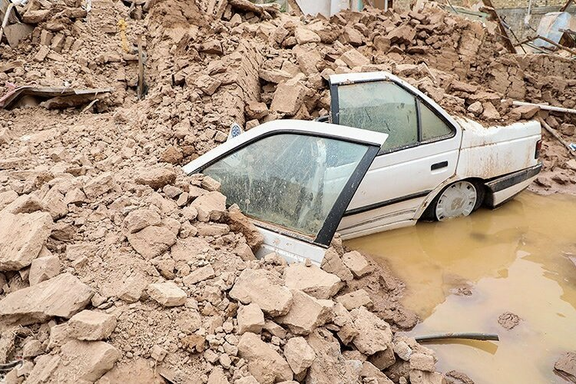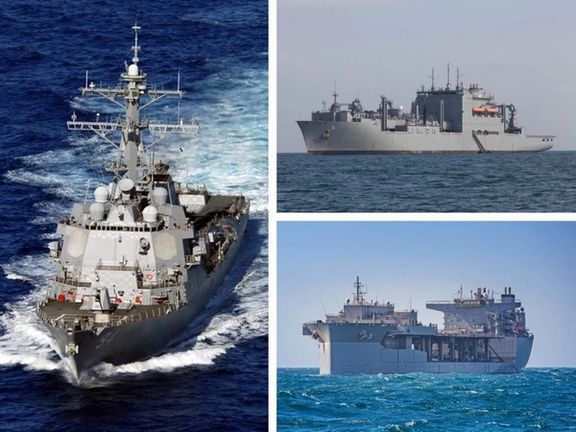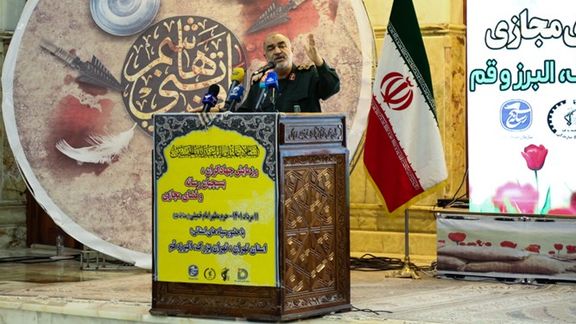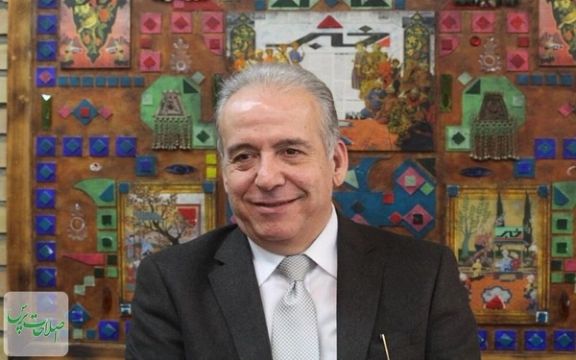Nearly 100 Dead In Iran’s Flood, Locals Say Over 200 Still Missing

A report by Iran’s Shargh newspaper says at least 200 people are still missing following the severe landslide and mudslide northwest of the capital Tehran last week.

A report by Iran’s Shargh newspaper says at least 200 people are still missing following the severe landslide and mudslide northwest of the capital Tehran last week.
The newspaper quoted locals as saying that the repugnant odor of the bodies which are buried under the mud has taken over the area around the Shiite shrine complex of Imamzadeh Davoud, one of the places worst hit by mud and floodwater. Some locals said they have seen many dismembered body parts.
Shargh claimed the locals had not been warned about the possibility of the flood beforehand, while Sahar Tajbakhsh, the head of the National Meteorological Organization, said in a TV program that the amount of precipitation was not anything new for the area, a valley that has experienced heavier rains with no such floods. She concluded that some construction or development projects must have changed the course of the water, causing the catastrophe.
According to official figures, as of Wednesday, 95 people are confirmed killed in the floods. More than 20 of Iran’s 31 provinces are affected by heavy rains and floods, with at least 20,000 homes destroyed.
Indian sub-continent summer monsoons usually bring some rain showers to Iran’s arid plateau, but every few decades the impact becomes more intense and causes flooding.
Partly due to the arid nature of the land and partly because of neglect in urban planning, even a modestly strong storm leads to deadly floods in Iran. Many dry riverbeds are choked off with construction or debris dumped by residents, leading to sudden flash floods in places no one expected.

Security forces laid siege to a village in northern Iran Tuesday and started demolishing houses and farms belonging to members of the persecuted Baha’i faith.
Simin Fahandej, a spokeswoman for the Baha’i International Community, told Iran International Tuesday that over 200 security forces were deployed to block the roads leading to Roshankouh, a village in Mazandaran Province, and begin demolition of the houses and farms belonging to Bahai’s.
According to Fahandej, security forces arrested some Bahai’s who tried to stop the operations, confiscated mobile phones of some villagers to prevent them from recording videos and publishing them on social media, and warned locals not to take any photos or videos of their operations.
A video posted on social media by the Baha'i International Community Tuesday shows security forces using heavy construction machinery to demolish buildings in Roshankouh.
Since early June security forces and the judiciary of the Islamic have intensified pressure on the followers of the Baha’i faith, raiding over a dozen households, arresting tens including three of the former leaders of the community, and shutting down businesses.
The intelligence ministry claimed on Monday that the arrested Baha’is were linked to the Baha’i Universal House of Justice in Haifa, Israel, and had collected information in Iran and conveyed it to their headquarters. The Universal House of Justice is the nine-member supreme ruling body of the Bahaʼi Faith.
In 2021 fifty Baha’i homes were demolished in the small farming village of Ivel in the same province and the authorities confiscated the assets of 27 Baha’i families who had lived there for several generations claiming that money earned by Baha’is is “unlawfully earned”.
The Worldwide Baha’i Community said in a July 20 statement that Tehran had intensified its systematic campaign to suppress the religious minority in recent weeks, either arresting, summoning to court, putting on trial or closing the businesses of at least 20 Baha'i citizens just in July. Baha'i Religious Minority Says Iran Intensified Persecution Of Members.
Established by Bahaullah in the 19th century, the Baha’i faith initially spread in Iran and parts of the former Ottoman empire and remained mostly confined to Iran and the Ottoman empire until after the death of Bahaullah.
The Baha’i Faith traces its beginnings to the religion of Ali-Mohammad Shirazi, known as the Bab (the Gate), the founder of Babism who claimed to be a messenger of God in southern Iran in 1844. The Bab who said God would soon send a new prophet to mankind was executed for heresy against Islam which considers Muhammad as the last prophet of God.
In 1863 Bahaullah, the founder of Baha’i faith who was banished from Iran and settled in Iraq later, announced that he was the prophet promised by the Bab. The leadership of Baha’is fell to his son Abdul-Baha after his death in 1892 near Acre in present day Israel.
Baha’is believe in Muhammad as a prophet of God, and in the Quran as the Word of God while the Shia clergy consider Babism and the Baha’i faith as heretical sects. Accordingly, Iranian clergy and officials often refer to Baha’is as “followers of the heretical sect”
For nearly three centuries the followers of the Bab and then Bahaullah have been persecuted in Iran to varying degrees and subjected to mob attacks often instigated by the Shia clergy.
Supreme Leader Ali Khamenei has on several occasions called the Baha'i Faith a cult and in a religious fatwa in 2018 forbade contact, including business dealings, with followers of the faith.
Baha'is, who number around 300,000 in Iran, say their rights are systematically violated and they are often harassed, forced to leave their homes and businesses, and are deprived of government jobs and university education.

IAEA Director General Rafael Mariano Grossi says that “good words” from the Islamic Republic are not enough to satisfy international inspectors
Grossi expressed hope on Tuesday that Tehran is ready to be transparent about its nuclear program, which was “moving ahead very, very fast”.
When asked about the IAEA's role in monitoring any revival of Iran's 2015 nuclear deal with world powers under which it curbed its nuclear program in return for economic sanctions relief, he said Iran must grant IAEA inspectors access “commensurate to the size” of its uranium enrichment program if the agency is to credibly assure that it is peaceful.
“When it comes to nuclear, good words will not do it. What you need to do is to be transparent and compliant and work with us. We are ready and I hope they will be as well,” Grossi told reporters at the United Nations.
“They have a very ambitious nuclear program that needs to be verified in the appropriate way. The program is moving ahead very, very fast and not only ahead, but sideways as well, because it's growing in ambition and in capacity.”
Iran's nuclear chief Mohammad Eslami told reporters in Tehran on Mondaythat Iran is technically capable of building a nuclear bomb; a statement that has been made before by at least two other Iranian officials and has been generally taken as a defiant signal from Tehran. President Ebrahim Raisi also reiterated last week that the people of Iran have told him they want to resist rather than sign an agreement with the United States.

The Israeli and the US navies have started a four-day joint military war game in the Red Sea as Jerusalem’s worries are growing about Iran’s presence in the region.
“The exercise is a bilateral training event between US 5th Fleet and Israeli naval forces that focuses on mission planning, maritime interdiction and other drills at sea,” the US fleet said on Monday, about a month after Defense Minister Benny Gantz warned that Tehran’s maritime activity in the area was the “most significant” in a decade.
The USS Nitze – a small destroyer with a crew of about 400 with cruise missiles for long-range land attacks and torpedoes -- the USS Lewis B Puller military cargo ship, and the USNS Matthew Perry logistical support ship are involved in the exercise.
The Israeli warships involved in the drill, the Saar 5 Class Corvette INS Eilat and the Sa’ar 4.5 Class Missile Ship INS Keshet, would “participate in a variety of missions alongside [US 5th Fleet] ships and a refueling tanker,” read a statement by the Israel Defense Forces.
Israel has held several naval exercises with the 5th Fleet since last November in the Red Sea, some alongside the UAE and Bahrain.
The US 5th Fleet -- headquartered in Manama, Bahrain -- includes maritime forces operating in the Persian Gulf, Gulf of Oman, Red Sea, parts of the Indian Ocean and three critical choke points at the Strait of Hormuz, Suez Canal and Bab al-Mandeb.
In July, Iran-backed Houthis of Yemen said Sana’a will not allow the Red Sea to become an “Israeli lake.”

There are one hundred thousand missiles in Lebanon, chief commander of Iran’s Revolutionary Guard, Hossein Salami Tuesday told a gathering of thousands of Basij militia.
In a speech in Tehran Salami said that Lebanon’s “Hezbollah youth have their fingers on triggers” and their leader Hassan Nasrallah with “determination is standing against the Zionists.”
According to IRGC-linked Fars website, Salami speaking to 6,000 Basij members on the occasion of the religious month of Muharram and the approaching Shiite holy day of Ashura, praised the voice “of Islamic resistance” from Lebanon and Syria to Yemen, including “around the artificial borders of the Zionist regime.”
The Islamic Republic uses the term “resistance” to refer to its proxy groups throughout the Middle East. Salami in his speech, however, went further telling the paramilitary Basij that they are past of a “global” Islamic resistance force.
He went on to praise Islamic Republic’s offensive operations in the region, mentioning confrontations at sea, “firing missiles at the enemy’s bases”, capturing enemy vessels as examples of “Islam’s power”.
Iranian proxy militias in Iraq and Syria have repeatedly attacked US bases with rockets and drones in recent years, and the IRGC has seized commercial vessels in the Persian Gulf.
The IRGC commander claiming that the enemy, meaning the United States, has been defeated, said that now it tries to win in a war of propaganda in cyberspace.
He was referring to anti-regime content by activists and ordinary Iranians on social media, which authorities cannot stop and blame on the US.

Iran can double its trade with China if US sanctions are lifted, but it would need 8 years to regain the economic status of 2010, a Tehran business leader says.
China has been Iran’s top trading partner in recent years and has helped with its overt and covert oil purchases since 2018 when the United States withdrew from nuclear deal known as JCPOA and imposed crippling sanctions on Iran.
The head of Iran-China chamber of commerce in Tehran, Majidreza Hariri told the Iranian Student News Agency (ISNA) in an interview that although China has taken a public stance against US sanctions, “but economic relations have their own characteristics and Iran should have its own special plans for neutralizing sanctions.”
Hariri in the past one year has repeatedly hinted at the economic benefits of lifting US sanctions, without commenting directly on the nuclear talks that have dragged on for 16 months without a result, keeping sanctions on Iran’s oil exports and international banking.
In April, the business leader said that if US sanctions are lifted, annual trade with China could top $60 billion. Last November he warned that Iran’s economy was at a dangerous juncture, with high inflation and a host of other problems. Since then, the national currency has lost more value and inflation has climbed to an annual rate of 54 percent.
Hariri also said that Iran would need eight years once sanctions are lifted to regain the same economic footing it had in 2010, when first international sanctions were imposed for its nuclear program.
Hariri told ISNA, “Despite many slogans, the economy was never a priority for Iran’s economic decision makers, and this has made current conditions so difficult.” He pointed out that while Iran’s oil and petrochemical products in the past had a strong market in China, now it has lost its position to others.
As an example of how sanctions impact ties with China, Hariri said that when a large Chinese operator of ports has 18 ventures in different countries, it cannot risk being targeted by secondary US sanctions. Nevertheless, he added, “China has shown cooperation with Iran for many years.”
Asked if a nuclear agreement is the only salvation for the economy, the businessman said that any agreement needs a 50-50 compromise and talks should continue to fruition, however Iranian officials in charge of the economy should also pursue other avenues to “neutralize sanctions,” to be able to emerge from the current “deadlock”.
Officials, particularly the followers of Supreme Leader Ali Khamenei’s hardline policies, who are currently in charge, often speak of “defeating sanctions” but in essence their efforts have marginal results. Most countries and international corporation shun business with Iran, which for more than a decade has attracted little foreign investment or large joint projects.
Russia on paper has promised many investments, or Iranian officials have claimed, but nothing significant has materialized. Recently, Moscow’s ambassador in Tehran complained that Iran owes Russia more than $700 million.
Iran last year signed a 25-year “strategic cooperation” agreement with China, which includes no specific provision for projects or investments. Officials in Tehran have said that the document is a framework based on which specific deals can be reached, but so far there is no sign of any large Chinese investments that Iran needs.